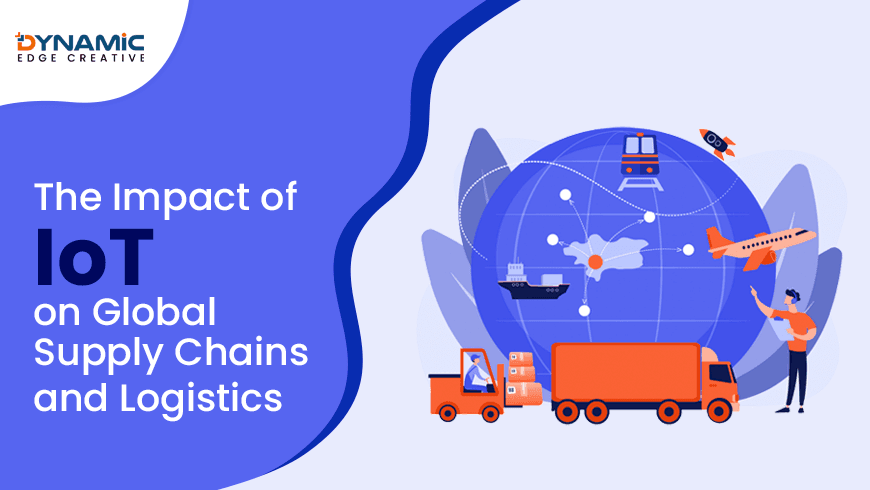
Do you know how the traditional methods of global supply chains and logistics work? They are troubled with inefficiencies and hazards. One of the major issues is a lack of real-time visibility and control over the flow of goods. It results in delays, stockouts, and increased expenses. The IoT (Internet of Things) technology provides a possible answer to these difficulties. It allows for real-time monitoring and tracking of shipments, inventory, and storage conditions.
IoT application development can transform supply chain management by integrating smart sensors and devices that collect and transmit data continuously. In this post, you can explore the impact of the Internet of Things on global supply chains and logistics.
Importance of Supply Chains And Logistics in Global Trade
In today’s interconnected world, Supply Chain Logistic have become the backbone of global trade. Supply chains involve a complex network of processes, organizations, people, activities, information, and resources. These all working together to deliver products to their final destination.
Logistics, on the other hand, focuses on the planning, implementation, and control of the efficient and effective flow and storage of goods, services, and related information from the point of origin to the end of consumption. Effective logistics is crucial for maintaining a competitive edge in the global marketplace.
What is IoT?
The Internet of Things is a technology that uses the Internet to connect several items. This connectivity enables these gadgets to communicate and interact with one another easily.
Nowadays, IoT capability is accessible for household appliances such as refrigerators, vacuum cleaners, and lighting.
This allows users to control these devices with voice commands, sensors, and mobile phones. Beyond its use in ordinary tasks at home, IoT has the potential to improve a wide range of commercial processes greatly.
The Role of IoT in Supply Chains
Imagine running a supply chain where your staff knows the exact location, condition, and destination of goods in real time. This becomes possible when you integrate the Internet of Things with supply chain processes. IoT application development creates specialized software solutions that facilitate the better interaction and communication of smart devices. Here is how it works:
☛ Process Automation and Monitoring
The IoT supply chain starts with the manufacturer, who utilizes process automation, remote monitoring, and production optimization. IoT sensors installed across the supply chain gather real-time data on the location, condition, and movement of commodities.
☛ Data Collection and Communication
The collected data moves through a communication network to a centralized IoT supply management platform. This ensures that information is transmitted quickly and efficiently from various points in the supply chain.
☛ Data Aggregation and Organization
Once the data reaches the centralized platform, it undergoes aggregation. Incoming data from numerous sensors is combined into a single dataset. The organized data is subsequently entered into a structured database.
☛ Data Analysis and Optimization
Finally, the structured data is analyzed to optimize various aspects of the supply chain. This includes improving warehouse management, enhancing logistics, and refining demand forecasting. Through this comprehensive approach, IoT significantly enhances the efficiency and responsiveness of operations of Supply Chain Companies.
IoT in Logistics
In the field of logistics, IoT is enabling a wide range of applications that are revolutionizing business processes. From shipment tracking and monitoring to predictive vehicle and equipment maintenance, IoT assists logistics providers in optimizing operations and increasing efficiency.
One of the most important applications of IoT in logistics is tracking and monitoring shipments. By integrating IoT sensors in packages and vehicles, logistics companies can follow the location and condition of items in real time.
Another important application of IoT in logistics is predictive maintenance. By monitoring the performance and condition of vehicles and equipment using IoT sensors, logistics providers can predict when maintenance is needed and take proactive steps to prevent breakdowns.
Benefits of IoT in Supply Chains and Logistics
The Internet of Things transforms supply chain management by enabling new levels of real-time visibility and control across the whole chain. Hiring professionals from IoT application development has numerous advantages who can greatly improve the efficiency of supply chain operations.
☛ Enhanced Visibility
One of the most important advantages of IoT in supply chain management is increased visibility. IoT sensors can track and monitor the location and condition of goods along the supply chain. This continuous real-time visibility enables businesses to optimize inventory management by ensuring they have the right amount of product at the right moment. For example, real-time tracking can assist in reducing stockouts and prevent overstocking. This degree of granular monitoring can also help detect bottlenecks and inefficiencies in the supply chain.
☛ Improved Efficiency
Efficiency is another significant benefit of using internet of things in supply chain management. IoT devices can automate various manual activities that were previously time-consuming and prone to human mistakes. For example, automated inventory level tracking can eliminate the need for manual counts. It also lowers the possibility of inventory record inaccuracies. IoT can also help to expedite maintenance tasks by monitoring equipment performance and forecasting when maintenance is required.
☛ Predictive Maintenance
IoT sensors play a crucial role in predictive maintenance by continuously monitoring the condition of machinery and equipment. These sensors can detect early signs of wear and tear or other issues that could lead to equipment failure. By predicting when maintenance is required, companies can perform maintenance activities proactively, thus preventing unexpected breakdowns and reducing downtime.
☛ Better Decision-Making
The real-time data generated by IoT devices enables businesses to make more informed decisions. For example, having access to current information on inventory levels, production rates, and logistics can assist managers in optimizing production planning and scheduling. This data-driven decision-making method can improve supply chain efficiency by better matching production with demand, lowering lead times, and increasing customer satisfaction.
☛ Reduced Waste
IoT technology can also contribute to reducing waste in the supply chain. Sensors that monitor the condition of goods can provide alerts when products are at risk of spoilage or damage. It allows companies to take preventive measures before losses occur. This capability is particularly beneficial in industries such as food and pharmaceuticals, where product quality and safety are important. By minimizing spoilage and waste, companies can save costs and also operate more sustainably.
Challenges and Risks
While using IoT in supply chain management is highly beneficial, it poses several challenges:
☛ Data Security and Privacy
IoT devices and sensors collect extensive data that must be securely protected. Creating a secure IoT architecture is complex, requiring expert teams to implement robust security measures to prevent data breaches and ensure compliance with privacy regulations.
☛ Integration and Interoperability
The IoT devices used across the supply chain often come from different manufacturers, creating challenges in integration and interoperability. Adopting universal communication protocols can help create a cohesive system, but achieving seamless integration remains a significant hurdle.
☛ Scalability and Complexity
As supply chain operations expand, scaling the IoT system to meet growing demands becomes challenging. This requires careful planning to manage the increased complexity of adding more devices and data sources while maintaining system efficiency and performance.
Future Trends in IoT for Supply Chains and Logistics
IoT application development is essential for transforming traditional operations into smart, interconnected ecosystems. As IoT continues to evolve and mature, several key trends are emerging that are likely to shape the future of supply chains and logistics:
☛ Edge Computing
As the volume of data generated by IoT devices continues to grow, there is an increasing need to process that data closer to the source. It is to reduce latency and improve real-time decision-making. Edge computing involves processing data on IoT devices or local servers rather than sending it to a central cloud, enabling faster response times and reducing the strain on network infrastructure.
☛ Blockchain Integration
Blockchain technology can enhance transparency, traceability, and security in supply chain transactions. By creating a decentralized, tamper-proof record of transactions, blockchain can help businesses track the provenance of goods and ensure compliance with regulations and standards.
☛ AI and Machine Learning
The vast amounts of data generated by IoT devices can be leveraged using artificial intelligence and machine learning to optimize supply chain and logistics operations. AI algorithms can analyze data on demand patterns, weather conditions, and traffic congestion to predict future events and optimize decision-making.
The Bottom Line
IoT is transforming supply chains and logistics. It provides businesses with unprecedented visibility, efficiency, and agility. Successful IoT application development can make your supply chains and logistic sector more efficient. As IoT continues to evolve and mature, you can expect to see even more innovative applications of this technology in supply chains and logistics.
Frequently Asked Questions
Please go through these FAQs so we can get to business quickly.
IoT improves supply chain visibility by enabling real-time tracking of goods and assets through sensors and devices. It provides detailed information on location, condition, and movement, which enhances transparency, and enabling proactive decision-making.
The benefits of IoT in logistics include real-time tracking, predictive maintenance, improved inventory management, enhanced security. It also optimize routing, and reduce carbon footprint. It leads to increased efficiency, cost savings, and customer satisfaction.
Challenges associated with implementing IoT in supply chains include data security concerns, interoperability issues, scalability problems, and maintenance requirements, requiring careful planning and investment to ensure successful integration.
